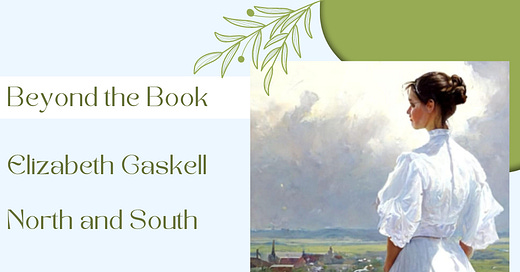It's been a few months since I finished Elizabeth Gaskell's novel "North and South”, originally serialized in twenty parts between 1854 and 1855 in the weekly magazine Household Words edited by Charles Dickens. Interestingly, while the author wanted to name the novel "Margaret Hale", referring to the protagonist, Dickens, who was writing his sociological-themed novel "Hard Times" at the time, insisted on the title "North and South". He won. :)
Gaskell's novel was met with skepticism by her contemporaries and literary critics, yet it later gained significant popularity, to the point that it was adapted into film three times.
Margaret Hale, from the sunny southern part of the country and daughter of a clergyman, moves north with her family after her father, citing matters of conscience, leaves his profession. They relocate with the intention of the father earning a livelihood by teaching John Thornton, a wealthy textile manufacturer.
The harsh, cold, textile-filled northern region, rife with tensions between industrialists and their workers, sharply contrasts the lighter, sunnier, agriculture-based southern part. Both Margaret and her mother suffer from the move; Margaret emotionally, witnessing the dire circumstances of the workers, and her mother physically, breathing the polluted air of the industrial town.
From this point on, the article contains spoilers. Those who haven't read the novel and don't wish to know more should stop reading and instead purchase the book!
Elizabeth Gaskell's novel ultimately explores how two individuals from vastly different worlds find each other despite their initial animosity. Through observing life's hardships, nineteen-year-old Margaret matures, and we follow her character's development of reconciling within herself the friendship formed with some of Thornton's workers and her slowly developing relationship with Thornton, who appears cruel at first glance.
What particularly struck me in the novel was how little direct dialogue there is between the two main characters. Yet the conversations they do have, along with the gestures they make for each other (often hidden from each other but revealed through other characters), beautifully lead to the climax where they finally come together.
While the novel showcases various societal tensions that Margaret finds herself amidst, responding initially with anger, judgment, and outrage, it also reveals that reconciling opposing interests and opinions is possible simply by recognizing the humanity in an opponent rather than lumping them into an antagonistic social group.
In the end, it's Margaret who bridges the gap between the strike-plagued Thornton and a prominent union leader, Nicholas Higgins. This bridge becomes so strong that by the novel's conclusion, they not only collaborate but deeply respect one another.
John Thornton's willingness to cross this bridge proves to Margaret that he is an honorable, humane man who, to the best of his abilities, tries to look out for his workers. Conversely, Margaret must come to terms with the constraints and circumstances within which members of the then-industrializing society, both capitalists and workers, operate.
Throughout the novel, bridges are built. Characters willing to reevaluate and change their views find friends, valued colleagues, superiors, and loving partners. Those unwilling to cross bridges find themselves consumed by circumstances. This is what happens to Margaret's mother, unable to reconcile with leaving her home.
Bridges form between Margaret's father and John Thornton, fostering friendship. Bridges are built between Nicholas Higgins and John Thornton, leading to mutual respect and fruitful collaboration. Friendships form between Margaret and Bessy, Nicholas Higgins' daughter, and by extension, between Margaret and Nicholas Higgins. Similarly, a bridge forms between Margaret and John Thornton, bringing love and a solution to bankruptcy caused by American competitors and ill-timed machinery upgrades.
By the novel's end, the author hints at a budding bridge between Margaret and John Thornton's mother, who strongly dislikes Margaret. However, it remains uncertain if the two women will be able to overcome their mutual disdain and meet in the middle.
To me, "North and South" is a novel about cross-class relationships, courage, and humanity. I'm delighted to have come across it, for, besides being uplifting, it prompted reflections on my prejudices, my openness to others, and how often I hold rigid views about situations or people without truly understanding the circumstances.
In addition to the lovable and lively characters, the story is thought-provoking and provides insights into the conditions of people living during the mid-1800s industrial revolution, making it an especially intriguing read. I highly recommend it!
– Eszter
Some links above are Amazon affiliate links, and if you buy something through these links I may earn a small commission at no extra cost to you.
Home | Notes | Articles | Eszter’s Magic | Literary Bonbons | Short Stories and Guides | Beyond the Book | EWE Issues | Archive | About




